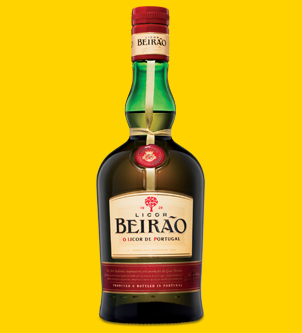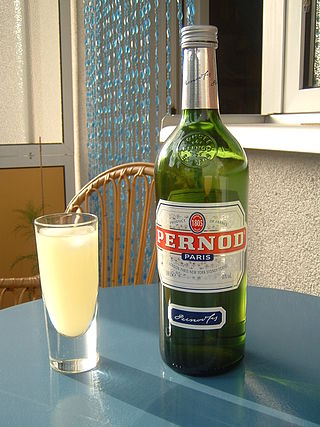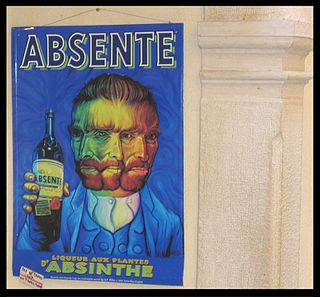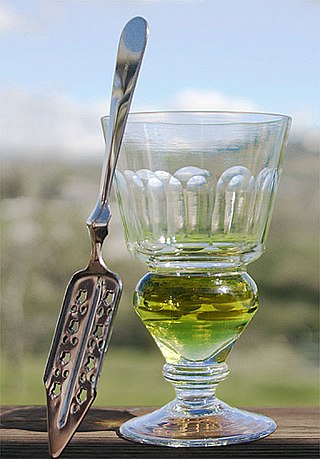
Obsello Absinthe Verte, or simply Obsello was a brand of absinthe. Obsello was an award-winning "Verte" or green absinthe that was manufactured by distillation from eight herbs including grand wormwood. [1] Obsello was distilled in California.

Obsello Absinthe Verte, or simply Obsello was a brand of absinthe. Obsello was an award-winning "Verte" or green absinthe that was manufactured by distillation from eight herbs including grand wormwood. [1] Obsello was distilled in California.
Obsello was a distilled verte, meaning that it was distilled from whole herbs steeped in alcohol, and colored using chlorophyll extracted from the herbs in a secondary maceration. [2] According to the company's website (now taken down), it was a natural product made in a historical manner. The ingredients included wormwood, Alicante anise, fennel, and five other herbs, spices, roots, and flowers.
The product contained less than 10 mg per kg of thujone in its final bottled state of 50% alcohol. It was therefore legal for sale in the EU and the USA.
Like many spirits verte absinthe improves materially with age and micro-oxidization. [3] [4] [5] This is attributed in part to the slow breakdown of the chlorophyll suspended in the bottle. [6]
Obsello was a natural verte absinthe and was thus colored with chlorophyll extracted from herbs in a secondary maceration process. This not only gave the drink its color but also imparted additional flavor of the drink. To prevent sunlight damage, Obsello was bottled in a UV-resistant bottle and had to be kept away from prolonged exposure to sunlight. [7]
Obsello Absinthe is no longer available via its main retail customers but old stocks may still be found in some US States.

Fortified wine is a wine to which a distilled spirit, usually brandy, has been added. In the course of some centuries, winemakers have developed many different styles of fortified wine, including port, sherry, madeira, Marsala, Commandaria wine, and the aromatised wine vermouth.

A liqueur is an alcoholic drink composed of spirits and additional flavorings such as sugar, fruits, herbs, and spices. Often served with or after dessert, they are typically heavily sweetened and un-aged beyond a resting period during production, when necessary, for their flavors to mingle.
Herbsaint is a brand name of anise-flavored liqueur originally created as an absinthe-substitute in New Orleans, Louisiana in 1934, and currently produced by the Sazerac Company.

Pastis is an anise-flavoured spirit and apéritif traditionally from France, typically containing less than 100 g/L sugar and 40–45% ABV.

Anisette, or Anis, is an anise-flavored liqueur that is consumed in most Mediterranean countries. It is colorless and, because it contains sugar, is sweeter than dry anise flavoured spirits. The most traditional style of anisette is that produced by means of distilling aniseed, and is differentiated from those produced by simple maceration by the inclusion of the word distilled on the label. And while Pastis is a similar-tasting liqueur that is prepared in similar fashion and sometimes confused with anisette, it employs a combination of both aniseed and licorice root extracts. Sambuca is essentially an anisette of Italian origin that requires a high minimum (350g/L) sugar content.

Chartreuse is a French herbal liqueur available in green and yellow versions that differ in taste and alcohol content. The liqueur has been made by Carthusian monks since 1737 according to instructions set out in a manuscript given to them by François Annibal d'Estrées in 1605. It was named after the monks' Grande Chartreuse monastery, located in the Chartreuse Mountains north of Grenoble. Today the liqueur is produced in their distillery in nearby Aiguenoire. It is composed of distilled alcohol aged with 130 herbs, plants and flowers.

Pernod is an absinthe produced by Pernod Ricard released in 2005 based on the original Pernod Fils recipe.

Absente is a brand name of 110 proof anise liqueur that has been marketed under the tagline "Absinthe Refined" since c. 2000. "Absente" is a French word that translates as "absent" in English.

Liquor is an alcoholic drink produced by the distillation of grains, fruits, vegetables, or sugar that have already gone through alcoholic fermentation. Other terms for liquor include: spirit, distilled beverage, booze, spirituous liquor or hard liquor. The distillation process concentrates the liquid to increase its alcohol by volume. As liquors contain significantly more alcohol (ethanol) than other alcoholic drinks, they are considered "harder." In North America, the term hard liquor is sometimes used to distinguish distilled alcoholic drinks from non-distilled ones, whereas the term spirits is more commonly used in the UK. Some examples of liquors include vodka, rum, gin, and tequila. Liquors are often aged in barrels, such as for the production of brandy and whiskey, or are infused with flavorings to form flavored liquors, such as absinthe.

Génépi or génépy is a traditional French herbal liqueur or apéritif popularized in the Alpine regions. Genepi also refers to alpine plants of the genus Artemisia that is used to make a liqueur in the French region of Savoy, where the Artemisia génépi plants grow and where the beverage is commonly produced.
La Fée Absinthe is a brand of absinthe, a highly alcoholic, distilled spirit containing the herb wormwood. La Fée Absinthe was created by Green Utopia, which is owned and run by George Rowley.

Piołunówka is a very bitter alcoholic infusion made by macerating wormwood in alcohol. Its name comes from Polish: piołun, lit. 'wormwood'. Piołunówka is considered a cure for problems with digestive tract and is believed to enhance appetite. Therefore, traditionally it is consumed in small amounts.

Pelinkovac is a bitter liqueur based on wormwood, popular in Croatia, Serbia, Montenegro, Bosnia and Herzegovina, North Macedonia, Bulgaria as well as in Slovenia, where it is known as pelinkovec or pelinovec. The alcohol content is 28–35% by volume. It has a very bitter taste.
Flavored liquors are liquors that have added flavoring and, in some cases, a small amount of added sugar. They are distinct from liqueurs in that liqueurs have a high sugar content and may also contain glycerine.
La Clandestine Absinthe is a Swiss La Bleue, or clear, absinthe brand produced by Artemisia-Bugnon distilleries. It is an anise-flavored, distilled liquor containing the herb wormwood, and when prepared with cold water will louche. La Clandestine Absinthe comes in four main styles, as detailed below.

Absinthe is an anise-flavored spirit derived from several plants, including the flowers and leaves of Artemisia absinthium, together with green anise, sweet fennel, and other medicinal and culinary herbs. Historically described as a highly alcoholic spirit, it is 45–74% ABV or 90–148 proof in the US. Absinthe traditionally has a natural green color but may also be colorless. It is commonly referred to in historical literature as la fée verte. While sometimes casually referred to as a liqueur, absinthe is not traditionally bottled with sugar or sweeteners. Absinthe is traditionally bottled at a high level of alcohol by volume, but it is normally diluted with water before being consumed.

Lucid Absinthe Supérieure is the first absinthe made with Grande Wormwood to be legally available in the United States after the repeal of the 95-year ban.
Kübler Absinthe Superieure is a brand of absinthe, distilled in the Val-de-Travers region of Switzerland also known as the "birthplace of absinthe". Kübler Absinthe was first produced in 1863 and was the first brand to be sold legally in Switzerland after the national ban on absinthe was lifted in March, 2005. The legalization of absinthe in Switzerland is largely due to Kübler's lobbying efforts. The United States Alcohol and Tobacco Tax and Trade Bureau (TTB) approved the formula for Kübler Absinthe in 2004, and approved the product for sale in the United States in May 2007 after three years of discussions among Kübler, Food and Drug Administration, TTB, and U.S. Customs and Border Protection. These discussions proved to be instrumental in opening the door for many brands of absinthe to be legally sold or produced in the United States.

Le Tourment Vert was an absinthe-like liqueur imported from the French Distillerie Vinet EGE, near the French commune of Cognac. The spirit was created in 2007.

Agwa de Bolivia, often shortened to AGWA, is a herbal liqueur made with Bolivian coca leaves and 37 other natural herbs and botanicals including green tea, ginseng, and guarana, distilled and produced in Amsterdam by BABCO Europe Limited. The coca leaf content of the drink, like that in Coca-Cola, has the cocaine alkaloids removed during production, and does not contain the drug.